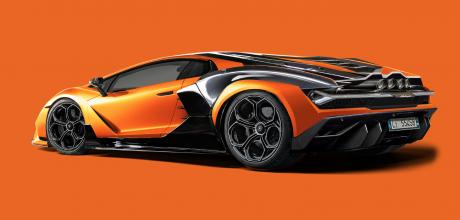Secret V12 Lamborghini – Countach bloodline goes hybrid
Lamborghini’s flagship V12 flirted with oblivion more than once – but lives on as the epically loud Revuelto.
TYPE-APPROVED IN HELL…
How do you follow the Lamborghini Aventador? We have the answer Sometimes developing a new car is plain sailing. But it can also be as convoluted and long-winded as the gestation of LB744, the Aventador replacement that almost didn’t happen.
Cast your mind back to 2018, and ponder these issues. Should the next Aventador launch before the Huracan replacement? Or the other way round, prioritising volume in these financially fragile years? And what of the mounting emissions issues? Ditch the V12 and switch to a V8 mid-cycle, with plenty of additional e-power instead? Performance hybrid, plug-in hybrid, no hybrid or fully electric?
It all sounds like ivory-tower ramblings today, but back in 2018 – when Lamborghini was already seven years into the life of the Aventador – anything was possible. CEO Stefano Domenicali would do as instructed just as the interim Audi CEO Bram Schot followed Wolfsburg’s orders – except that Herr Diess was not even sure whether the group should hang on to Lambo and Bugatti. After a drive in an LB744 prototype – ‘Too big, too heavy, not fast enough’ – Herbert ordered the R&D team back to the drawing boards.
Four years later, new CTO Rouven Mohr and his team are putting the finishing touches to a car defined by his sidelined predecessor, Maurizio Reggiani. When Stephan Winkelmann took over from Domenicali and Markus Duesmann replaced Schot, it was clear the Aventador would remain faithful to the established formula, with a longitudinally-mounted, turbo-free 6.5-litre V12. Now redlined at a sky-high 11,000rpm, this state-of-the-art engine – a €50m project – uses pre-chamber direct-injection technology.
The software and PHEV battery are from Rimac, whose expertise facilitates improved efficiency, up to 40 per cent greater range, ultra-fast recharging via energy regeneration, strong performance repeatability and slow degradation. Smart algorithms ensure maximum power on the track and more sustained hot-lapping than the Ferrari SF90, sources say.
The wheelbase is the same at 2700mm, but length (4942mm), height (1160mm) and width (2030mm) are all up. The re-engineered modular carbonfibre ‘monofuselage’ chassis will find a second home in the Huracan replacement – without such synergies, supercars could not survive. As far as the Revuelto goes, we expect the coupe in the summer of 2023 and the roadster in 2024, with a Super Veloce in 2026 and the SV roadster in 2027.
All models were again designed in-house by Mitja Borkert. Signature touches include eye-catching front and rear light graphics, bold proportions, shape-shifting aerodynamics and a track-inspired cockpit. The new Aventador does not share any componentry with other group products. Like the V12, the eight-speed Graziano DCT is a bespoke item, featuring no reverse gear (the e-motor does the honours) and an integrated mechanical locking diff.
The double-wishbone suspension relies on steel springs, adjustable dampers and active anti-roll bars. Dynamic torque vectoring and a by-wire rear-wheel-steering system also feature. On-demand all-wheel drive is provided by two e-motors, with up to 265bhp going to the front wheels. Even with the supercapacitor fully charged, the zero- emissions range barely exceeds 10 miles. Lamborghini expects this configuration to yield better take-off traction, greater corner-exit speeds and a broader scope of handling qualities than competing rear-wheel-drive layouts. Even though the PHEV module adds weight and complexity, it is just about the only opportunity to dial in more power and torque by playing with battery size, e-motor specification and performance electronics.
We expect a starting price of €425,000 (£380k) in Italy before extras like the lightweight Nardo pack. Interested parties better be brave: like its predecessor, the Revuelto will invariably draw a crowd. And that’s before you fire up the majestic V12 which, if sources are to be believed, must have been type-approved in hell, so loud is it. We still owe you more answers about how this all fits into Lamborghini’s big picture. Yes, it was okay to launch LB744 first because the Huracan STO and Technica fill the Huracan gap with aplomb – and because Audi has now two more years to decide what to do with its gooey R8/Rnext programme. Since the EU7 emissions norm is no longer worth the paper it was printed on, the high-mech V12 can soldier on some more – as can Lambo’s own new 4.0-litre V8, earmarked for the 2024 Huracan replacement – although the 2035 cut-off point that will force everyone to go electric seems set in stone.
Ferrari’s EV supercar arrives in 2025. By contrast, Lamborghini is not expected to fully electrify its sports cars any time soon, but will concentrate instead on a clean-air fourth model range which should yield the brand’s first compact SUV, an electrified smaller sibling to the Urus, in 2028.
NEED TO KNOW
- What is it? The next chapter in the Countach/Diablo/Murciélago saga, now part-electric
- Tech? Hybrid e-power for all-wheel-drive traction – and even more power
- Aimed at? Big egos with bigger wallets
- When can I have one? This summer
Owners will be able to move away silently on e-power – but none will.


